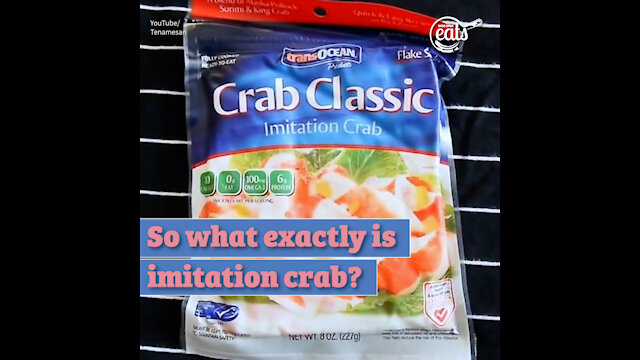Premium Only Content

What Exactly is Imitation Crab and Should You Eat It?
We've given you lots of recipes that rely on crab meat, and for good reason. Crab is delicious and you can incorporate it into so many different kinds of dishes, making it useful for appetizers and main dishes alike. Crab is a versatile seafood, but it's also expensive. As with other luxury ingredients, if you could find a good substitute, you'd probably use that.
FEATURES
FOOD
RECIPES
HOMESTEAD
LIFESTYLE
HOME-COOKING
imitation crab
Sarah Ramsey
What Exactly is Imitation Crab and Should You Eat It?
SARAH RAMSEY POSTED OCTOBER 13, 2020
We've given you lots of recipes that rely on crab meat, and for good reason. Crab is delicious and you can incorporate it into so many different kinds of dishes, making it useful for appetizers and main dishes alike. Crab is a versatile seafood, but it's also expensive. As with other luxury ingredients, if you could find a good substitute, you'd probably use that.
Fortunately, there is an alternative to expensive crab, but what is imitation crab exactly? Is it good, and is it good for you? Let's take an in-depth look at this mock seafood.
Mock meats have been around a long time, although they're growing in popularity. Veggie burgers take the place of beef, and there are infamous soy-based products like Tofurkey. But imitation crab meat isn't technically a mock seafood, because the main ingredient is actually fish.
Surimi, which is Japanese for "ground fish," is bits of fish blended together to form a paste. According to The Japan Times, "surimi has been used in Japan for over 800 years in the form of kamaboko, a kind of seafood log that can be produced in various shapes and colors, which is sliced and most commonly added to soups."
The kamaboko is the precursor to the crab stick, which was invented by Katsuichi Osaki at the Osaki Suisan Company in 1974 in Kusatsu, Japan. Osaki added red food coloring to the crab stick and cut them into strips so that they would look more like crab legs. Crab sticks are often used for sushi, specifically to make California rolls.
Here's a fun fact: Surimi is made here in the United States. Although imitation crab was being imported from Japan and was becoming popular with consumers, there wasn't a welcoming atmosphere for producing surimi products domestically until the 80s, says Alaska Pubic Media. But with the collapse of a king crab fishery in Kodiak, food suppliers were looking for an alternative and Alaska fisheries catch a lot of Alaskan pollock which, as it turns out, is the perfect fish to make imitation crab.
Imitation crab doesn't include any actual crab meat, and although it does include fish, today only about half of the seafood product is made with real fish, mostly a white fish such as Alaskan pollock. Food manufacturers use egg whites and starch to give the food its shape, and flavorings including salt, sugar and other sweeteners, and natural or artificial flavors to give it a crab-like taste.
Nutritionally speaking, imitation crab has less fat and cholesterol than real crab meat. However, it also has less protein and fewer nutrients than the real thing, and it has more sugar. Some brands add other fillers like sorbitol for preservation, vegetable oil for texture and to extend shelf life, and monosodium glutamate (MSG) for flavor.
Imitation crab, in spite of its nickname as the "hot dog of the sea," isn't inherently bad. In fact, in many dishes, it's a smart, cost-effective choice. If you're mixing the crab with other ingredients, as with crab dip or a seafood salad, using quality imitation crab can make your food budget go farther.
But like all processed foods, take a good look at the label to see exactly what is in your imitation crab before buying it. And if you're eating out, ask if the crab cakes or crab rolls are the real deal or made from surimi.
-
 1:18
1:18
WideOpenEats
3 years ago9 Sonic Secret Menu Items for Your Next Trip to the Drive-In
8.43K -
 3:33
3:33
The Go-to Business Tax Information Channel
4 years ago $0.02 earnedWhat Expense Softwares Should You Use?
106 -
 2:13
2:13
NowYouKnowEnglish
4 years agoWhat Safety Should You Follow On Social Media? *
9141 -
 2:13
2:13
NowYouKnowEnglish
4 years agoWhat Safety Should You Follow On Social Media?
1.59K -
 4:00
4:00
sayeed amin
4 years agoWhat You Should Eat on the Ketogenic Diet | keto Diet
149 -
 3:06
3:06
WEWS
4 years agoHere's what you should know about MRNA vaccines
5.34K16 -
 2:03
2:03
Final Start Fitness
4 years ago $0.01 earnedWhat Macros Should You Eat First On Your Plate
86 -
 1:24
1:24
The DIY Homeseller Channel
4 years agoWhat Exactly is Title Insurance
101 -
 4:37
4:37
Kip Sells Homes
4 years agoWhat Should You Avoid Doing In A Seller's Market.
38 -
 0:20
0:20
Fiona_is_my_bitch
4 years agoFIONA KNOWS EXACTLY WHAT SHE WANTS 1.2021
2.26K